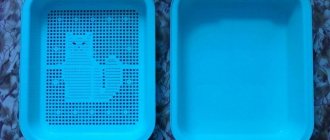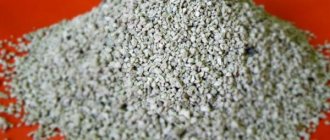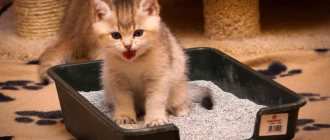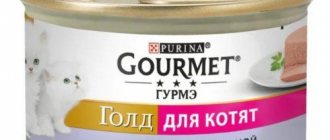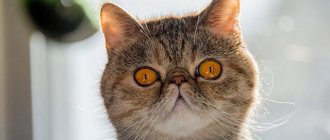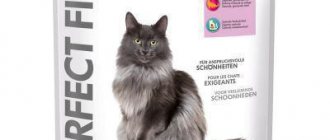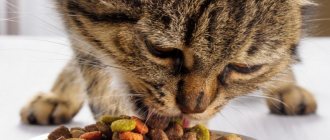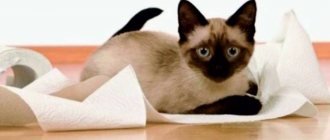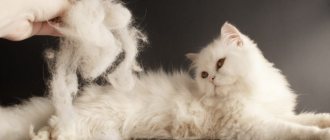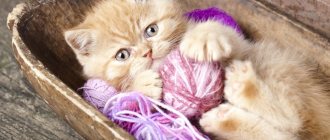A tray for a small pet is an essential item. The success of toilet training a kitten largely depends on the correct choice of litter box. The modern pet industry offers a huge number of different models: from the simplest and most budget-friendly to the super-functional and expensive. In order not to get confused in the store, it is useful to get acquainted with the advantages and disadvantages of different models in advance.
What to consider when choosing?
When choosing a model, you need to take into account not only the preferences of your little pet, but also the ease of use of the tray for humans: cleaning, absorption of unwanted odors, transportability. It is important to immediately decide on the location for the toilet so that you know what size will suit you. Experienced breeders give the following recommendations:
- The kitten should easily climb into the container, so you need to choose a height for the sides so that they do not become an obstacle for the baby. Otherwise, he may relieve himself not in the right place, but nearby.
- Size is very important: it should not constrain the animal.
- It is better to decide in advance on the type of model - open or closed.
- Pallets made of lightweight plastic are easily overturned, so it is better to choose more stable options.
- If the model is difficult to care for, it is not easy to wash it and remove the filler, it is better to abandon it. Cats are very clean and can ignore a poorly cleaned litter box.
The cost of an accessory does not always determine the right decision. The most important points are comfort and suitable size. If the tray is inconvenient for the baby, the process of toilet training will be delayed and will require additional effort and time from you.
Rating of the best indoor toilets for cats
| Nomination | place | Name of product | price |
| The Best Inexpensive Indoor Litter Boxes for Cats | 1 | Moderna Trendy Cat Cats In Love | 1 859 ₽ |
| 2 | MPS Netta 54x39x40 cm | 1 240 ₽ | |
| 3 | HOMECAT 53x39x42cm | 1 446 ₽ | |
| 4 | SAVIC Duchesse 44.5x35.5x32 cm | 734 ₽ | |
| The best indoor toilets in the mid-price segment | 1 | Curver PetLife 51*39*40cm | 3 572 ₽ |
| 2 | Ferplast Maxi Bella 50x47x65.5 cm | 4 570 ₽ | |
| 3 | Toilet box N1 Mak 102 | 3 255 ₽ | |
| The best indoor toilets for cats in the premium segment | 1 | Cat Genie 120 | 34 900 ₽ |
| 2 | PetSafe ScoopFree Ultra 70.2x40.6x48.6 cm | 17 995 ₽ | |
| 3 | Pidan "IGLU" | 7 900 ₽ |
Plastic tray with low sides
This is the most popular option. It is as simple as possible, it looks like a plastic pallet with sides of different heights and shapes.
Advantages:
- does not create obstacles for the kitten, as it is convenient to climb into it;
- inexpensive, therefore, if necessary (violation of integrity, the appearance of a persistent odor that cannot be gotten rid of), it can easily be replaced with a new one;
- convenience when replacing the filler, which can be easily poured into a bag or drain;
- easy to clean – a one-piece open container without additional parts can be washed without difficulty;
- transportability – plastic products are lightweight and compact, they can easily be moved or taken on a trip.
Flaws:
- does not protect against scattering of filler due to low sides;
- The plastic is quite soft, so over time it will inevitably develop scratches that cannot be washed out;
- requires the mandatory use of filler;
- Does not block unwanted odors.
One of the modifications is a pot with sides curved inward. It is more practical, as it prevents the filler from spreading, but is less practical to maintain. It is not easy to wash the inner surface of such sides, and it is not always possible to shake out the dirty filling right away: the pieces fall under the bend, and it is difficult to get rid of them without additional equipment.
Plastic toilet with grate
It is a regular plastic tray with a mesh insert inside. We can say that this is an improved modification of a simple tray.
Advantages:
- the grid protects the kitten’s paws from getting wet, so all the liquid flows to the bottom;
- solid feces remain on the mesh and can be easily removed with a dustpan;
- easy to clean: both the tray and the grill can be easily washed with a stream of water;
- the filler does not spread around and does not stick to the cat’s paws, that is, it does not spread throughout the apartment, as it is usually poured under the net.
Flaws:
- does not block unpleasant odors without filler;
- It is more difficult to clean than usual, since it consists of two parts;
- Disliked by cats who prefer to bury excrement.
The option with a grid involves a little trick: you can pour just a little heavy filler (mineral, silica gel or clumping) onto the grid, and a well-absorbing filler under the grid. This way the cat will have something to scratch, but the smell will remain in the lower part of the tray and will not spread throughout the house.
Owner reviews
We also tried a lot of things, but we haven’t found a better tray with high sides with clumping filler BIO CAT”S. And for kittens I have a tray with small sides - they still go there. And as mentioned above, from the first steps. Now the little ones are already a month old and they saw where mommy and auntie were rummaging, they are trying to climb in there too. Yesterday I removed small poop from there, which means the sides are not a hindrance even for such little ones.
irinkin1506
https://www.thaicat.ru/forum/45–1735–1
Not every tray that is suitable from a human point of view is suitable for a cat. And the fact that you throw her poop there, collected in the corners, nothing fundamentally will change - a self-respecting cat, and this is what true British and British women are without a doubt, will not go into any tray that you offer her as a vessel for coping with natural needs. Here are the main reasons why cats shit everywhere. Only by following the following rules can you train your cat to go to the toilet without any problems: The cat should like the place where the toilet is located. It should be easily accessible ALWAYS and not in the aisle, so that the cat can calmly do its business. The cat should like what was offered as a toilet. A well-mannered, neat and clean cat can disdain a small tray with a bare mesh, as well as torn newspapers and sand from a neighboring sandbox. The tray should be large and comfortable, so that there is room to fit it, with clean filler. It must be spacious, especially for the cat (!), otherwise, at best, the cat will sit in the tray with his butt outside, and in the worst case, he will refuse to use this “spit can” altogether.
Natasha
https://britishcat.net/forum/viewtopic.php?f=11&t=128
My British girl, when she was little, went to the litter box, then, when she grew up big and big, she began to “miss” next to the litter box.
Alex Raduga
https://mauforum.ru/viewtopic.php?f=134&t=5855&start=20
My cat goes to the toilet with high sides, and it’s fine, I buy heavy clumping litter, nothing spills out, he also digs in hard..
furgy
https://forum.ngs.ru/board/pets/flat/1963045588/?fpart=1&per-page=50
Since you are using filler, you need to choose a deep tray. Those. The depth should be sufficient so that the cat can dig around to its fullest without scattering the litter. As a rule, such trays have a fastened side at the top that is bent inward, this also prevents the filler from scattering.
CatsMom
https://prokotov.com/index.php/forum/ukhod-za-koshkami/448-kakoj-lotok-luchshe-vybrat-dlya-koshki
My cat has a standard litter box: rectangular, with a mesh on top. The net was removed; somehow it wasn’t very convenient to use it. When our cat was a kitten, we bought litter, but I have large pots of flowers on the floor at home, and she sometimes “did things” there. We stopped using the filler and the problem was solved. So it remains, it “goes” into the empty tray, I don’t even tear up the newspaper - it’s very convenient, the main thing is to change it after each time, it doesn’t go into the wet anymore.
Olga128
https://prokotov.com/index.php/forum/ukhod-za-koshkami/448-kakoj-lotok-luchshe-vybrat-dlya-koshki
High-sided toilet
Such modifications are suitable for older kittens and adult animals. They usually consist of two parts - a pallet and a removable frame.
Advantages:
- high walls and a frame around the edges protect the room from contamination: granules do not fly out, even if the cat paddles with all his might;
- easy to clean: the frame is removed and the container is washed under running water;
- it is possible to increase the volume of filler to reduce the unpleasant aroma;
- the design allows you to insert a bag or film inside and fix it with its sides; this greatly simplifies the process of replacing the filler: it is simply removed along with the bag and thrown away.
Flaws:
- not compact: takes up quite a lot of space, may not fit in a small bathroom;
- for small kittens it is very high - they cannot climb into it, so it is more suitable for teenagers and adult animals.
Hint: a tray with sides can be installed outside of the bathroom - if there is not enough space there. For example, some owners place the cat litter box on a closed loggia or in the hallway.
Types and manufacturers
There are three types of cat toilets. They are fundamentally different from each other, although they have a common function - independent drainage of excrement without direct human participation:
- A device similar to a human one, but filled with special granules. For example, CatGenie products. There is no need to pour the usual filler into such a toilet. It is filled with special granules, through which liquid excrement flows into the drain. Solids are collected with a special rotating scoop. The owner can set a convenient cleaning time: the tank will wash itself, the granules will be cleaned and dried. This type of self-cleaning cat litter requires a connection to sewerage and electricity. You can do this yourself or call a plumber. Suitable for almost all cat breeds. Equipped with a sensor.
The CatGenie automatic toilet requires minimal human intervention during the cleaning process
- A device similar to a human one, without granules. No different from the ones people use, except that you need to add your preferred filler. It’s possible without it at all, but many cats refuse to go into a tank that they can’t dig into. This also includes sensory toilets that do not require filler. They work like this: the cat comes in, does its business, and leaves. The sensor reads presence. When the cat leaves the tank, smart technology counts down the set time and then drains. The most famous manufacturer is Kopfgescheit.
- Tray with self-cleaning function. Operating principle: looks like a regular tray, but somewhat more complicated. When the animal goes into it, a special device will collect and send excrement to the lower tank, and the worker will become clean again. For such toilets, it is necessary to purchase special bags for excrement. Once a week you will have to remove them, every day you will have to clean the tray by pulling a special lever. One of the famous brands that produce similar products is Hagen smart sift. The manufacturer has one more “highlight”: the car toilet is produced in the form of a cozy house that is suitable for absolutely all breeds. It has a significant disadvantage: you can’t get rid of the smell until you change the waste bag.
Tray with ventilation
A relatively inexpensive modern model that replaces a dry closet. Suitable for installation not only in the bathroom, but also in most places in the house.
Pros:
- has an additional tray with holes through which air flows;
- constant air movement ensures rapid drying of the filler substrate;
- perfectly blocks unpleasant odors;
- is a budget version of a dry closet.
Minuses:
- the cat steps on the granules with its paws, they can stick and spread around the apartment;
- requires maintenance (washing), unlike automatic dry closets.
The most suitable type of filler for such a toilet is silica gel or clumping.
Tray houses (closed)
Such options are suitable for pets who love to dig or shy individuals. When choosing such a design, you need to take into account the comfort for the baby and ease of care (some tray houses are difficult to wash). They are available in different sizes, designed for kittens and adult cats.
Pros:
- good blocking of unpleasant odors;
- protection against spillage of filler;
- aesthetic design, due to which you can install a tray-house right in the room.
Minuses:
- bulkiness - this model is not suitable for small apartments;
- difficulty in cleaning or, another option, constant change of filter mats, and this involves additional expenses.
There are many modifications of litter boxes, the main thing when choosing is to take into account the dimensions of the pet. The cat should feel free inside. You can buy a toilet for kittens to grow up with.
Kitten litter
A good litter for kittens reliably retains unpleasant odors and a sufficient amount of liquid, does not settle on the animal’s fur and does not stick to the paws, plus it has a good price/quality ratio.
Recently, consumers have begun to pay special attention to product safety.
- For people and animals: if you have an allergy, then dust, even a small one, is undesirable.
- For the environment - the filler must be environmentally friendly and easily recyclable.
Based on the type of liquid absorption, all fillers are divided into two large groups - absorbent and clumping.
Absorbents , also known as sorbents, absorb moisture evenly, the substrate does not stick together, and the whole thing is changed every few days. Based on the composition of raw materials, they are divided into natural mineral and organic, and more recently also synthetic sorbents.
Mineral (clay) fillers are inexpensive. But clay is dusty and cannot be washed down the drain. A composite filler with activated carbon will be noticeably more expensive, but it copes better with odor and has to be changed much less often.
Organic (wood-cellulose) sorbents made from paper, sawdust, cereal husks, corn cobs, etc. plant waste have less absorbency than mineral fillers, but are more environmentally friendly. Raw materials are abundant, the cost is low, and used filler is often disposed of in the sewer system.
Silica gel sorbents do an excellent job of removing odor and producing little dust. The best samples work so well that it is enough to change the filler once every two to three weeks, or even once a month. Freshly crushed silica gel granules (the cheapest option) emit a specific crackling sound of varying volumes, produce a large amount of dust and effectively cope with odor only for a week. Granules that have undergone two additional treatments generate virtually no dust, make minimal sounds and work for almost a month. But they also cost more, accordingly.
Clumping litters for kittens and adult cats form a lump when exposed to moisture, which can be easily removed using a special scoop. Since the liquid binds chemically, the lumps are dry and odorless. Among them are clay (from finely dispersed bentonite clays) and organic (wood, paper, corn, soy). Clay ones produce a denser lump, but are made from non-renewable raw materials and create disposal difficulties. Organic ones can be flushed down the toilet or composted, are convenient to clean up, and are quite economical in price. Recently, more expensive options have appeared on the market, produced using advanced technologies; they produce a dense lump and cope well with odor.
Corner tray
As the name suggests, this tray can be placed in a secluded corner. This model is especially convenient to use in a small apartment when there is no space to install a rectangular tray. Therefore, if you have little space in your apartment, it is definitely better to choose a corner litter box for your kitten.
The toilet has an ergonomic shape with rounded corners. It can be the simplest, with a mesh, with a filter, or even in the form of a house. This is a combined type of closed and corner trays.
The open version of the corner model is equipped with high sides. Due to this, granules of hygienic filler do not spill out.
Snail, or Clean Paws
The “snail” tray is a closed structure resembling a shell, with steps at the entrance. Coming out of the tray, the cat walks along the ladder and thus shakes off the remaining litter from its paws. The top of the structure is equipped with a filter that absorbs unpleasant odors.
This cat litter box has an aesthetic appearance and is usually liked by furry pets because of the additional sense of security. Individual snail toilets are designed pieces of art.
When choosing this option, make sure that the design allows you to easily clean the pot. It may be difficult to train a kitten that is used to an open litter box. Decide which tray is best for a kitten based on its characteristics.
Tips for choosing
Before you decide on one of the litter options for your cat, evaluate the litter trays based on the following criteria:
- Product material . Make sure the toilet is made of durable plastic. During operation, the material should not be damaged by the claws of an animal or turn over under its weight. It is also desirable that the plastic be environmentally friendly, hypoallergenic and odorless.
- Dimensions. It is critical that the litter box is the right size for your cat. It should fit comfortably in it and not bend the container during use. For a closed litter box, match its height and width to the size of the cat. She shouldn't be cramped. Choose small trays for kittens only on the condition that you will later replace it with a larger one. And, of course, the dimensions of the toilet must match your living conditions.
- Weight. The lightweight model is convenient for owners, but is not always suitable for comfortable use by cats. Before purchasing, make sure that the animal cannot turn over the open tray and move the closed house from its place.
- Design. If the choice is between open and closed type, then the first one is better suited for kittens or for simultaneous use by several pets.
- Ease of cleaning. Open models usually clean quickly and easily. But closed toilets need to be assessed for the ability to access hard-to-reach places and the difficulty of disassembly and maintenance in general.
Self-sifting toilet
Perhaps the most hygienic option of all trays. All you need is to tilt the tray to the side, and the soiled filler will be poured through the mesh into a special tray. You then remove the tray and throw the waste into the trash. You don't have to go through such a tedious and unpleasant procedure as sifting through used cat litter with a spatula. Everything happens automatically.
It should be noted that not all animals like this design - it is not very stable. And the price is steep (from 5,000 rubles). Often you can only buy such a tray in a foreign online store.
Disposable cat litter
Many cat owners, when choosing a tray, by the question “which tray is best for a kitten” mean the question “which tray is more convenient for me?” Therefore, their choice often falls on disposable cat litter.
The main advantage of disposable cat litter is that the kitten owner gets rid of unpleasant procedures: emptying the tray of used litter, cleaning and washing the tray before the next fill of litter. Instead, the used disposable toilet is thrown away and a new one is installed in its place.
A disposable cat litter box is a box made of micro-corrugated cardboard, inside there is a plastic tray into which heat-treated granules of natural opal-cristobalite sorbent with a high ability to absorb and retain odors are poured. The service life of a disposable tray is approximately a month.
Significant disadvantages: you still have to remove solid excrement yourself with a scoop, and you need to buy a tray quite often.
Recommendations for use
When using each cat litter box model, there are some nuances associated with the design. Much depends on whether filler will be used (if so, which one).
Experienced cat breeders advise first purchasing a tray design that is familiar to the animal, and then making adjustments. It is recommended to use the same litter that the cat used previously.
It is extremely important to choose the right location for your cat's litter box. It should be quiet and fairly secluded. You need to make sure that the animal is comfortable and comfortable. Otherwise, it may start to crap in places not intended for this.
Particular attention is paid to regular thorough cleaning and washing of plastic parts. Excessive contamination should not be allowed. If the smell is very strong, the cat will not go to his potty. Ideally, you should try to clean up after your pet after each bowel movement. From time to time, the pot needs to be treated with disinfectants that are safe for animals and do not have a pungent odor.
If several pets live in the house, then it is necessary to have an individual toilet for each.
If there are several cats in the house, then each one needs a personal potty.
There should always be a certain supply of filler and film in the house if a tray with removable sides is used.
Toilet nozzles
The toilet cover is a simulator for accustoming a cat to the toilet and looks like a regular tray. They are installed on the rim of the toilet and are initially used as a regular toilet with filler.
As the cat gets accustomed to the tray, a hole is made in the center of the pad, which expands over time. Many models are a ready-made “pyramid”, where you don’t need to cut anything: the hole is expanded by first removing a small rim, then a larger one, then even more, and so on.
As soon as the animal begins to steadily do its business in the toilet, the nozzle is removed. Of course, training takes quite a long time. Therefore, it is recommended to choose a regular kitten tray as a backup option to avoid unpleasant surprises near the toilet or in the secluded corners of your apartment.
